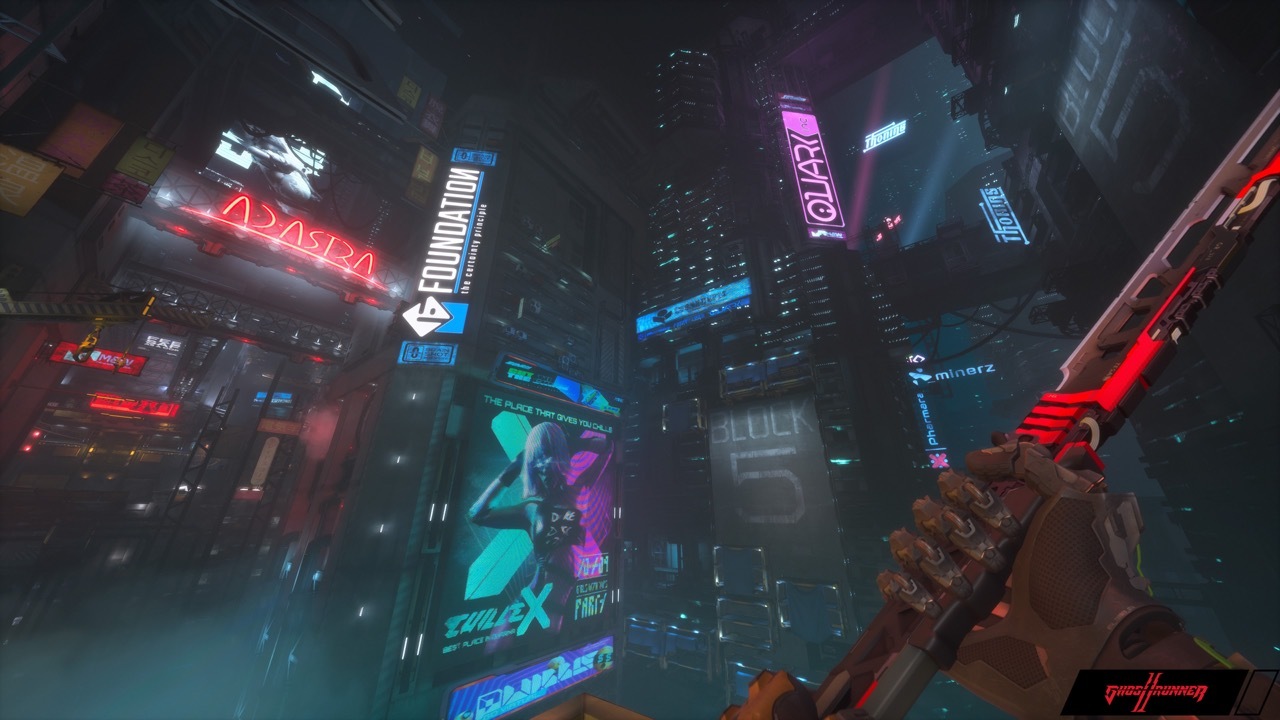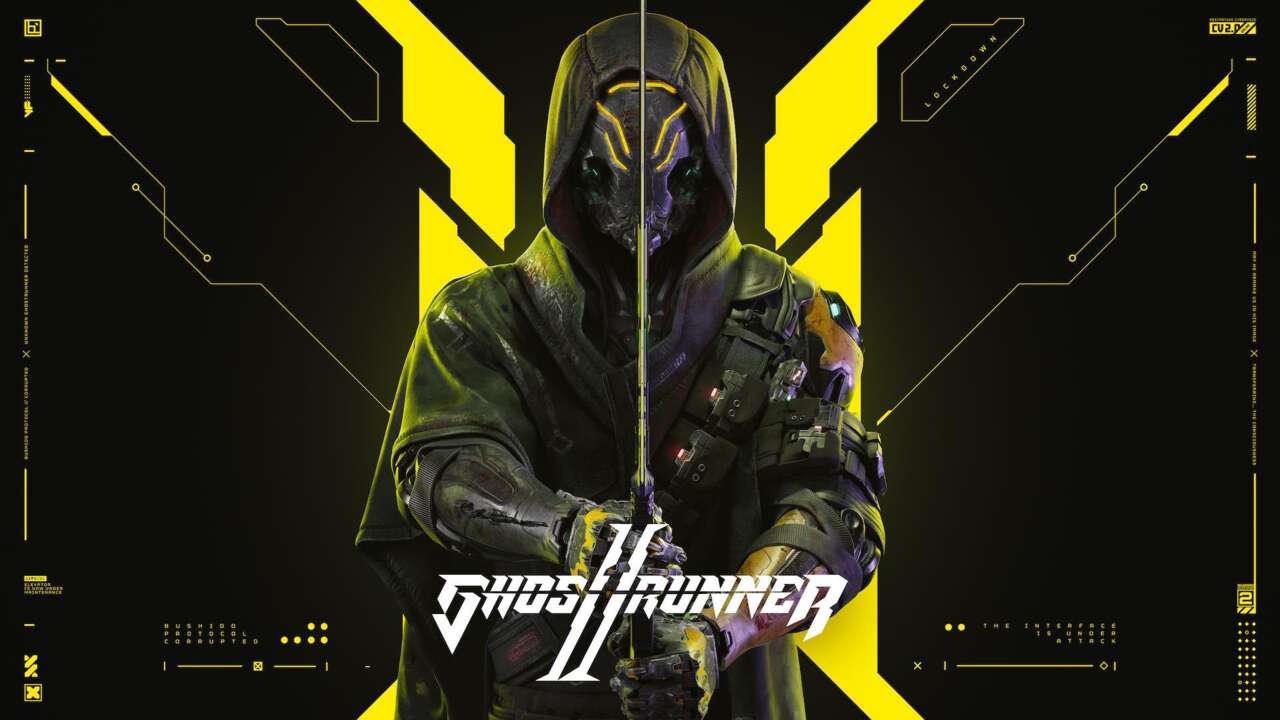When it launched in 2020, Ghostrunner was quickly recognized for its slick blend of satisfying first-person parkour platforming and tough-as-nails, one-hit-kill combat. Perhaps most impressive was just how well it practiced restraint, never overstaying its welcome while also keeping the focus keenly on its engaging traversal and action. Ghostrunner II is a sequel that hasn’t entirely lost the captivating nature of its core gameplay loop, but in expanding the world that you’re playing in and trying to find new elements to introduce into the mix, it loses itself along the way at times before finding its feet once again.
Ghostrunner II takes place a year after the events of the first game, with cyborg assassin Jack now comfortable in his role as enforcer for the Climbers, one of many gangs trapped in the cyberpunk tower of Dharma. While the original Ghostrunner had a story, it wasn’t a core focus, instead simply providing some context to keep you moving forward. In the sequel, the narrative is far more prevalent, which can make many of its opening moments confusing if you haven’t brushed up on the events of the first game or the encapsulating lore of the world the game takes place in.
You’ll have numerous radio conversations with a variety of characters, many of which are exposition-heavy explanations to get you up to speed as quickly as possible. It makes the opening hours feel overwhelming and disjointed, before the story eventually settles into a predictable revenge plot that leaves little room for nuanced characterization. There are some entertaining exchanges between Jack–whose blunt but self-aware responses are surprisingly hilarious for a single-purpose killing machine–and some of his handlers, but Ghostrunner 2 doesn’t feature a fleshed-out cast of characters or captivating story beats that you’ll likely remember by the time credits roll, and certainly not long afterwards.

Gallery
Thankfully, you don’t need a particularly compelling story reason to enjoy Ghostrunner’s main draw. Just like before, you’re able to elegantly zip around levels with speed and grace, chaining together wall runs, speedy slides, whiplash-inducing grapples, and nimble jumps. Ghostrunner 2’s stages feature some extensive platforming portions, all of which use new and existing mechanics in continually novel ways. What might have been a simple wall run a few levels prior is turned into one that requires a shuriken lodged into a wall before you can grapple to it, with the added challenge of having to also disable a deadly electric field in your way at the same time. Ghostrunner 2 rewards thinking and reflexes in equal measure, but balances them well enough that you’re often making it through platforming gauntlets without too many deaths. This retains the sense of accomplishment when you do reach the ground safely again without forcing it through frustration, making each bit of progress feel rewarding.
Throughout your time running around Dharma Tower and beyond, you’ll encounter pockets of enemies in small arenas that impede your progress. These start off simple, with melee fodder that rush towards you and riflemen with semi-automatic weapons that quickly become trivial to deflect with your trusty katana. Even in the early hours, Ghostrunner 2’s combat is challenging. You still die after taking a single hit, but more importantly, so do each of the enemies that you’re up against. That applies to the mindless drones and all the way up to bipedal, laser-launching robots. This ever-present sense of danger transforms combat into a intense dance, one where your reactions to the changing skirmish are just as important as your initial approach. While combat encounters aren’t designed to be tackled in a specific order, they are certainly structured to discourage certain paths, forcing you to figure out an efficient order or operations before executing it with deadly accuracy, leaving nothing but the blood of your enemies staining your blade.
This process of learning each new skirmish remains as exhilarating in Ghostrunner 2 as it was in the original game. Dashing in mid-air to avoid a projectile before decapitating the foe it originated from, only to then launch into a slide to close the gap to another nearby foe and deftly deflect a projectile back at him is just a small example of the tightly strung-together movements you’ll not only regularly pull off, but be required to master to progress past Ghostrunner 2’s challenging (albeit fair) combat. Enemies are intelligently placed to give you a perfectly natural path between them, making your execution feel choreographed as you combine your understanding of timing and target prioritization.
As you progress, you’ll gain access to new abilities that expand your repertoire in both combat and platforming. Returning abilities, like the shuriken, give you a much-needed ranged option in fights, stunning enemies and creating a new grapple point that opens up more ways to flow between them. Another lets you create a copy of yourself while you are cloaked, which can sometimes work well with a third ability that affords you a short-range kinetic push, perfect for enemies on precarious ledges. The shuriken gets the most use out of the three, especially when it comes to its integration in regular platforming. Both stealth and the small force push are featured in some inventive puzzles to solve in the areas immediately after you acquire them, but beyond that, their usefulness is not explored further, which feels like a missed opportunity.
Each of these abilities, as well as your basic attacks and movement options, can be upgraded through a slightly convoluted system of acquiring passive upgrade chips and then assigning them into places on a circuit board. This board grows as you collect chips scattered throughout each level. You will come across some not too far off the beaten path, and many of them require careful examination of each area if you’re wanting to unlock the entire board before reaching the end of the game. It works against the principle of continually moving forward, stunting the pacing somewhat to a degree that I often found myself sacrificing the upgrade potential for a better overall time. Coupled with the fact that only a handful of upgrades make meaningful differences to the way you can play, and, conversely, how you can survive better in a fight, it’s likely that you’ll find yourself settling in with a build early on and potentially forgetting to improve it.
It’s in the ways that Ghostrunner 2 attempts to expand on these core fundamentals, and ultimately move away from them, that it starts creating friction with the components that work. It’s most clearly evident around halfway through the campaign: You’re equipped with a motorbike and quickly set off on a high-octane chase to escape Dharma Tower, leaving behind the setting that has served the series completely up until this point. The chase itself is entertaining enough, with elements of combat and platforming still present as you slash power conduits to open massive blast doors and leap off your bike to avoid the laser barrier, before deftly grappling back to it as it races ahead.
As soon as you blast your way out and into the wasteland outside the tower, however, Ghostrunner 2 loses its footing. The levels here show an ambition to expand gameplay into more open areas, jumping between traversal on your bike and small combat interludes when you arrive at yet another locked gate blocking your path. Ghostrunner 2’s lengthiest level is one that presents you with three objectives to complete, letting you decide which order to tackle them in. This alone isn’t novel, and the order doesn’t seem to make any tangible difference on the remaining objectives, so all it enforces are extended periods of driving between the three in a needlessly convoluted open area devoid of any interesting challenges or skirmishes.
Ghostrunner 2 tries to use this change in environment to introduce new enemy types and provide even more backstory to the game’s narrative, but considering that each new enemy is simply a reskin or an existing archetype and that most of the story is delivered through conversations as you drive around a barren, brown landscape, it’s a uninteresting detour from Dharma Tower that takes up a good third of the total runtime. Its only saving grace is an incredible boss encounter that rounds out your time away from the tower. It’s an impressive amplification of scale that doesn’t just use more space for the sake of it, but instead presents a combat encounter that is delightful during each of its stages while making innovative use of the new mechanics Ghostrunner 2 has to offer. The same can be said for every boss fight throughout the campaign, barring a weak showing with the game’s initial one in the very first stage. Unlike its limited space to move and rote enemy patterns, other bosses are complex fights that push you to use your skills and honed reflexes in new ways. They’re extended bouts with forgiving checkpointing that make the common repetition of phases as you learn a foe more educational than wholly frustrating, representing the highest points in Ghostrunner 2’s combat at each juncture.
A part of what makes your time spent away from the tower so frustrating is the stark contrast between the intrigue of Dharma’s construction and the mundane nature of everything outside of it. Once you return, the flood of bright neon lighting that bathes avenues with delicate touches of the many struggles that have occupied them is immediately more interesting than a collection of sand, rocks, and abandoned buildings with nothing to say about their history. Dharma Tower invokes a lot of familiar cyberpunk imagery that has dominated games in recent times, but Ghostrunner 2 still stands out thanks to welcome variety between districts, be it the ominous halls of a religious cult that has technology hiding behind its sacred walls, or the exposed framework of a system collapsing under the weight of its purpose when scaling some of the outside walls. Moving through Dharma Tower is a delight that is accentuated by a pulsating soundtrack carried by riveting synth rhythms, many of which kept my foot tapping to the beat as I continued about my death-dealing duties.
It’s difficult not to enjoy the rhythmic nature of Ghostrunner 2’s finely-tuned blend of parkour and action, and it’s also impossible to ignore some of the ways this sequel tries, but fails, to expand on its predecessor in terms of scope. It’s disappointing that in most regards the increased ambition detracts from what makes Ghostrunner so captivating in the first place, taking time away from the expertly designed combat arenas and satisfying platforming gauntlets and using it instead to explore a barren, empty world with no novel ways to traverse it. Ghostrunner 2’s narrative also fails to provide a compelling stopgap to ease the transition between these two distinct phases of the game, but when this sequel does course-correct back to what made it so popular to begin with, it provides an enthralling action experience. Ghostrunner 2 pulls back just in time before getting too close to the sun to remain an entertaining sophomore entry in the series that hopefully won’t end here.

